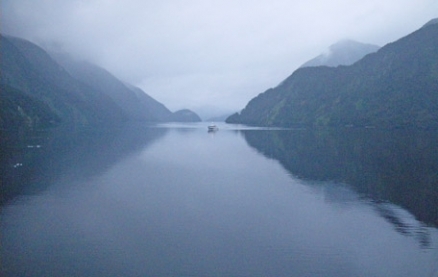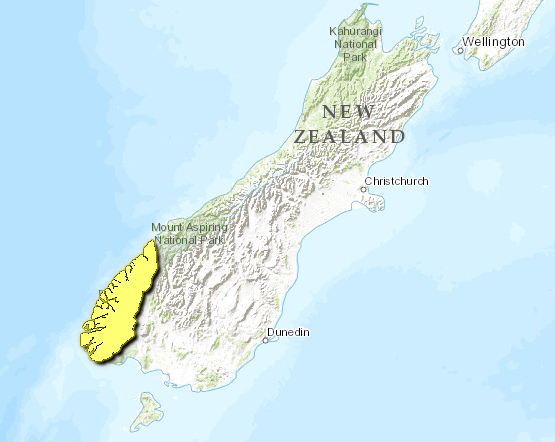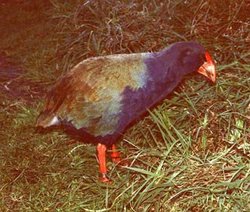Fiordland temperate forests
The Fiordland temperate forests are dominated chiefly by Nothofagus genus trees and occupy a coastal area of southwest South Island, New Zealand. Fiordland is a region of snow-capped mountains, steep-sided fiords, deep lakes, unbroken forests, and tussock grasslands. Its character is almost entirely natural, and indigenous species dominate the flora and fauna. This wild and remote area is virtually uninhabited and the majority is protected within Fiordland National Park, New Zealand’s largest at 12,570 square kilometres (km2).
Location and General Description
Fiordland occupies the southwest corner of New Zealand’s South Island. The oldest rocks in the region, which contain fossils some 500 million years old, were uplifted about 350 million years ago. The intense forces involved created very hard, crystalline igneous and metamorphic rocks (gneiss and granite) that are relatively resistant to erosion. As a result, the region has retained spectacular glacial landforms and looks much as it would have earlier in this fifth Ice Age some 10,000 years ago. Glacial landforms include U-shaped valleys, 250 metres (m) deep fiords lined by sea cliffs 2,000 m high, alpine lakes that sit in cirque basins, and waterfalls that plunge dramatically from hanging valleys. However, there is evidence that some areas remained free of ice, and these areas served as significant refugia for the region’s biota.
The mountains are not as high as those in the Southern Alps (a maximum of 2746 m here compared with the Alps which have 19 peaks over 3000 m), but the forested sides are precipitous. The topographymeans that there is no potential for agriculture, forestry, or urban development. Like Westland to the north, the region has very high rainfall – up to eleven m per year on western slopes. Rainfall decreases moving in from the coast so that the eastern parts of this region receive roughly five m of rain each year. The cold-tolerant silver beech (N. menziesii) dominates the fjord area right down to sea level, while inland red beech (N. fusca) lines the valley floors with mountain beech (N. solandri var. cliffortioides) at higher altitudes in the drier eastern mountains. Mixed podocarp/beech forest grows around the terraced [[coast]al fringes] of Waitutu in the southeast of the region. Heathlands grow on ultramafic rocks and on shallow soils over the weathering-resistant rocks of the ecoregion.
Above the treeline, there are extensive areas of tussock herbfields as well as bog vegetation around the numerous tarns and small wetlands. There are nine different species of Chionochloa snow tussocks and a wide variety of alpine herbs. Penalpine and alpine endemics include Hebe pauciflora, Aciphylla takahea, and Celmisia inaccessa.
The major lakes and rivers in Fiordland represent the largest forested system of inland waterways in New Zealand. The three main lakes, Hauroko, Manpouri, and Te Anau, are also the deepest in the country. The lakes and their surrounds have diverse vegetation which includes several threatened and locally endemic species such as Brachyscombe linearis, Ranunculuus recens lacustris, and Hydratella inconspicua.
Biodiversity Features
The variety of habitats in Fiordland allows a diverse flora and fauna to thrive and the region’s isolation has encouraged endemism with over 700 higher plants found only in Fiordland including 24 alpine plants. Fiordland also supplied habitat for some very unusual and rare birds. The endangered takahe (Porphyrio mantelli), the largest living member of the rail family, was thought to be extinct until 1948 when a few pairs were rediscovered in Fiordland’s Murchison Mountains. It declined rapidly in the 1940s and 50s as the number of red deer (Cervus elaphus) increased. Deer compete with takahe for food (contributing to loss of condition and chick mortality) and damage their habitat. The species recovered slightly after deer control was implemented, but even so, only about 130 birds remain in Fiordland. Fiordland was also a stronghold for the critically endangered kakapo (Strigops habroptilus), the world’s largest and rarest parrot. The kakapo is now probably locally extinct with the last known birds transferred to predator-free islands in the 1970's.
Insect life is abundant with more than 3000 recorded species of invertebrates, about 10 percent of which are probably endemic to the region. However, reptiles are less abundant, with the only species known to be present being the Fiordland skink (Oligosoma acrinasum). The Fiordland skink is found on two mainland locations and the exposed rocky shores of numerous islands along the Fiordland coast. Their distribution has declined due to alien species predators.
Waitutu in the southeast contains dune sequences not found elsewhere in Fiordland and a unique series of elevated marine terraces. Rimu (Dacrydrium cupressinum) is common on these boggy terraces, an unusual feature in a region otherwise dominated by beech forests and alpine herbfields. The area also has an abundance of wildlife, including 25 nationally vulnerable species.
Current Status
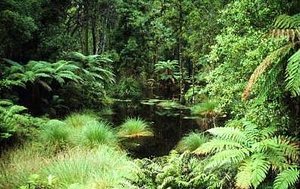 Fiordland National Park, New Zealand. (Photograph by WWF-Canon/James W. Thorsell) Almost all of this area is protected within Fiordland National Park. In 1986, Fiordland National Park and the combined Aoraki/Mount Cook and Westland National Parks were recognized as separate World Heritage areas. These original sites joined with Mount Aspiring National Park in 1990 to become the single vast Te Wahipounamu South West New Zealand World Heritage Area (26,000 km2).
Fiordland National Park, New Zealand. (Photograph by WWF-Canon/James W. Thorsell) Almost all of this area is protected within Fiordland National Park. In 1986, Fiordland National Park and the combined Aoraki/Mount Cook and Westland National Parks were recognized as separate World Heritage areas. These original sites joined with Mount Aspiring National Park in 1990 to become the single vast Te Wahipounamu South West New Zealand World Heritage Area (26,000 km2).
Along the Fiordland coast and in the fiords there are many islands that are pest-free (although a number are within swimming range of goats and red deer (Cervus elaphus), and thus remain at risk) and all are included within Fiordland National Park. Of note are the Breaksea, Outer Gilbert, and Entry Island groups which have been designated Specially Protected Areas. They are nationally significant for their largely unmodified ecosystems and populations of threatened species. They offer further potential for species transfer.
Waitutu, in the southeast, is the least protected part of the region, but even here 67 percent of the region is administered by the Department of Conservation (including a large section that was added to Fiordland National Park in 1992).
Types and Severity of Threats
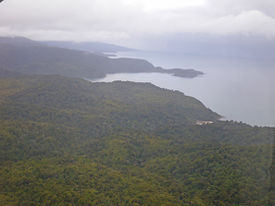 Unspoiled expanse of beech forest, Fiordland. @ C.Michael Hogan
Unspoiled expanse of beech forest, Fiordland. @ C.Michael Hogan
As with other regions in New Zealand, Fiordland’s ecosystems are threatened by alien species predators and competitors (e.g. red deer), rats (Rattus rattus and R. norvegicus), mustelids (Mustela erminea, M. nivalis, and M. putorius), and possums (Trichosurus vulpecula) prey on birds or bird eggs. However, Fiordland does have a number of predator-free offshore islands and 30 percent of the mainland is still possum free. It is vital to keep possums out of this remote, as yet unaffected, area, but control is difficult because of the inaccessibility of the terrain and the widespread nature of the surrounding possum alien species populations.
Some of Fiordland’s extensive alpine herbfields were modified by red deer grazing during the 1940s and 50s. Recovery is occurring now that the deer population has been significantly reduced by helicopter hunting, and has been maintained at a low level for some time.
Management of parts of the protected areas is questionable, with certain introductions of non-native vegetation at locations such as Te Anau; in addition, that same location has high visitation, and hence sprawling urbanisation for visitor infrastructure as well as resident population.
Fire, habitat modification, and invasion by weeds are less of a problem than in other regions of New Zealand because of the largely intact nature of the ecosystems, the region’s remoteness, and the extremely wet climate.
Justification of Ecoregion Delineation
There is complete agreement between the Fiordland temperate forests ecoregion and Wardle’s Fiordland Botanical Province. The entire ecoregion is composed of granite and gneiss mountains and original vegetation is largely intact, consisting of beech forests, heathlands, and subalpine grasslands.
Further Reading
- For a terser summary of this subject, see the WWF WildWorld profile of this ecoregion.
- Department of Conservation. 2000. Conservation Management Strategy for Mainland Southland/West Otago 1998 – 2008. Southland Conservancy Conservation Management Planning Series No 9. Invercargill.
- Department of Conservation website. http://www.doc.govt.nz New Zealand Department of Conservation].
- Hilton-Taylor, C. 2000. The IUCN 2000 Red List of Threatened Species. IUCN, Gland, Switzerland and Cambridge, United Kingdom. ISBN: 2831705657
- Hutchings, G. and C. Potton, editors. 1987. Forests fiords and Glaciers, New Zealand’s World Heritage. Royal Forest and Bird Protection Society of New Zealand, Wellington.
- Molloy, L. 1988. Soils in the New Zealand landscape: the living mantle. Mallinson Rendel. Wellington. ISBN: 0908606559
- Molloy, L. 1994. Wild New Zealand. New Holland Publishers. London. ISBN: 0262133040
- Patterson, G. 2000. Skinks on the edge. New Zealand Geographic 47: 61-80.
- Wardle, P. 1991. Vegetation of New Zealand. Cambridge University Press, Cambridge, United Kingdom. ISBN: 193066558X
| Disclaimer: This article contains information that was originally published by the World Wildlife Fund. Topic editors and authors for the Encyclopedia of Earth have edited its content and added new information. The use of information from the World Wildlife Fund should not be construed as support for or endorsement by that organization for any new information added by EoE personnel, or for any editing of the original content. |
